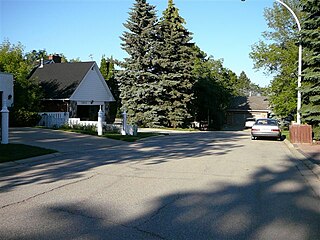
Lynnwood is a residential neighbourhood in west Edmonton, Alberta, Canada. Its location gives residents good access to downtown, the University of Alberta, MacEwan College, and West Edmonton Mall. It became a part of Edmonton when the Town of Jasper Place amalgamated with Edmonton in 1964.
Beverly is a former urban municipality within the Edmonton Capital Region of Alberta, Canada. Beverly was incorporated as a village on March 22, 1913 and became the Town of Beverly on July 13, 1914. It later amalgamated with the City of Edmonton on December 30, 1961. The population of Beverly was 8,969 at the time of amalgamation.
Rundle Heights is a residential neighbourhood overlooking the North Saskatchewan River valley in the City of Edmonton, Alberta, Canada, named for Methodist missionary Robert Terrill Rundle. While the neighbourhood didn't develop until the 1960s and 1970s, the area is closely associated with the Town of Beverly, a working class community that amalgamated with Edmonton in 1961. A number of the Beverly coal mines were located in the area.
Bergman is a neighbourhood in east Edmonton, Alberta, Canada located immediately to the north of the Town of Beverly townsite. The neighbourhood is named for Gustav C. Bergman who was elected mayor of Beverly in the first municipal election after Beverly incorporated as a town in 1914.
Abbottsfield is a neighbourhood in east Edmonton, Alberta, Canada overlooking the North Saskatchewan River valley. The neighbourhood is named for Abraham Abbott, a resident of the Town of Beverly and long time school custodian in the Beverly School District. While development of Abbottsfield didn't begin until nearly a decade after the amalgamation of Beverly with Edmonton in 1961, the neighbourhood is located in an area closely associated with Beverly. Beverly was a coal mining town, and one of the major Beverly coal mines was located in the Abbottsfield area.
Beacon Heights is a residential neighbourhood in Edmonton, Alberta, Canada that was part of the Town of Beverly before Beverly amalgamated with Edmonton in 1961.

Spruce Avenue is an irregular shaped residential neighbourhood in Edmonton, Alberta, Canada. The neighbourhood is home to Kingsway Mall, the Glenrose Rehabilitation Hospital, the Northern Alberta Institute of Technology, the Norwood Extended Care Hospital, Spruce Avenue Community Center, Spruce Avenue Junior High School, and St. Basil Catholic Junior High School. The neighbourhood takes its name from the former designation of 114 Avenue.

Glenwood is a large neighbourhood in west Edmonton, Alberta, Canada. The neighbourhood has a mixture of residential and commercial development. Glenwood became a part of Edmonton in 1964, when the Town of Jasper Place amalgamated with Edmonton.
Parkview is a residential neighbourhood in west Edmonton, Alberta, Canada. Parkview is one of the larger residential neighbourhoods in the city, and is located adjacent to the North Saskatchewan River Valley in the west portion of the City. The neighbourhood has good access to Whitemud Drive and Stony Plain Road, and the interior street layout is based on a modified grid network.

Laurier Heights is a residential neighbourhood in west Edmonton, Alberta, Canada overlooking the North Saskatchewan River valley. A portion of the neighbourhood along Buena Vista Road is located in the river valley, and this portion is sometimes called Buena Vista.

Grandview Heights is a residential neighbourhood in south west Edmonton, Alberta, Canada. It is built on land that had been owned in the 1880s by a family named McCauley.

Ottewell is a large residential neighbourhood in east Edmonton, Alberta, Canada. "The area is named for the Ottewell family, who were among the first settlers south of the river in the 1880s".
Terrace Heights is a roughly triangle-shaped residential neighbourhood in south east Edmonton, Alberta, Canada.
Aspen Gardens is a residential neighbourhood in south west Edmonton, Alberta, Canada, overlooking the Whitemud Creek Ravine. The neighbourhood "was designed to appeal to individuals and families in search of quiet, affluent residential neighbourhood characterised by larger homes, mature trees, and attractive paths for pedestrian and bicycle travel."

Capilano is a residential neighbourhood in south east Edmonton, Alberta, Canada. The neighbourhood, established in the 1950s, overlooks the scenic North Saskatchewan River valley.
Forest Heights is a residential neighbourhood in east central Edmonton, Alberta, Canada that overlooks the North Saskatchewan River valley to the north and west. Four bridges provide access to destinations on the north side of the river.
McLeod is a residential neighbourhood in north east Edmonton, Alberta, Canada.
Calder is a residential neighbourhood in northwest Edmonton, Alberta, Canada. The area was originally part of the Hudson's Bay Company reserve and was settled by employees of the Grand Trunk Pacific Railway.
Rosslyn is a residential neighbourhood in north west Edmonton, Alberta, Canada. The neighbourhood has good access to shopping services at Northgate Centre and North Town Mall.
Highlands is a residential neighbourhood in north east Edmonton, Alberta, Canada overlooking the North Saskatchewan River valley. The area was annexed by Edmonton in 1912, and "was named in a contest offering a 50-dollar prize." In 2012, Highlands was ranked one of Canada's top ten neighbourhoods of old homes by the magazine This Old House.







